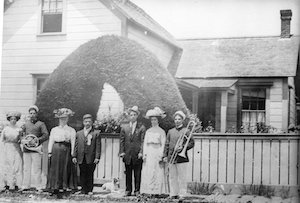
The John Q. and Maria Brown family, in front of their house at 45270 Calpella Street, on Pentecost Sunday, 1905. From left to right: Annie, Frank, Maria, John Q., “Spot”, Joseph, Mayme, and John J.
March 26, 1846 – John Q. Brown, a pioneer of Mendocino, was born at Punto del Gada on the island of Flores, Azore Islands. The Beacon reported, “Of his childhood, we know that from his tenderest years, he was remarkable for his strict honesty, candor and veracity. At the age of thirteen, he was taken from his native soil and put on board a whaling vessel bound for Behring Sea via Cape Horn. For seven years, his was a life of adventure on the sea. During that time he cruised along the coasts of Alaska and China now braving the perils of whale fishing, now risking his life among the ice floes. At times he was attacked by Chinese pirates and more than once he was almost murdered by Esquimaux. Once, on a dark night while sailing near the north coast of Japan his vessel struck a rock and was wrecked. Fortunately, all souls were saved and he with his mates was treated with great kindness by the natives until a passing vessel rescued the ship-wrecked crew.”
In 1869, John landed in San Francisco, where he met and married his first wife, whose name is unknown. Unfortunately, she contracted a serious illness, and eleven months after their marriage she passed away. In 1878, John married Maria Gloria Victor, who was born on the island of Pico, Azores, and came to this country as a young woman in the early 1870s. John and Maria had 10 children. Those who survived to adulthood were Frank, who married Vernie Jamison; Mayme J., who remained single; John J., who died at 36; Emily, who married Antone B. Lemos; Annie, who married Bert Stone; Andrew, who died at 17; Carrie, who married Herbert Redmayne; and Joseph, who married Mamie Vincent.
John worked in the lumber yard and was in charge of the chute at the Shipping Point. He operated the motors that hoisted the slingloads of lumber that went down by cable to the lumber schooners anchored in Mendocino Bay.
Fun-loving and social, John organized feasts and celebrations. He served on a four-man committee with Antone Fernandez, Antone Perry, and Frank Valadao, raising funds to build Crown Hall.
John died on April 4, 1914. His funeral “was attended by a large number of friends of the deceased. The local mill and lumber yard and the schools closed out of respect to the memory of the departed. A touching and eloquent eulogy was delivered by Rev. Father Raymond. Interment took place in the local Catholic cemetery, numerous beautiful floral offerings being placed upon the grave.”
Walking Tours of Historic Mendocino – Join our expert docents for a stroll and lively commentary. You’ll pass by early pioneer homes, historic meeting places, and buildings that make up the the Mendocino Historic District.